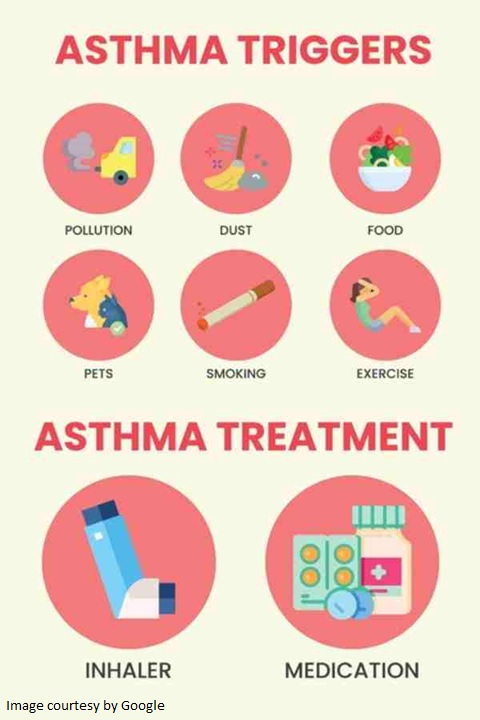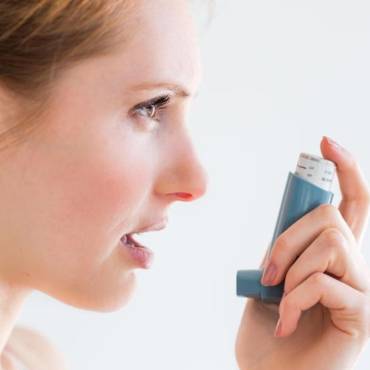Prevention and long-term control are primary in stopping asthma attacks before they start. This page is for you if you’re among those who wonder if can asthma be prevented? The goal of this blog is to provide quality care by offering appropriate information on prevention and treatment to people with asthma.
Asthma management: General principles
Asthma meaning: Asthma is a lung disease that affects the airways, making it tough for a patient to breathe.
How to prevent asthma: The long-term goals of asthma include symptom control and risk reduction. The aim is to decrease the burden on the patient and their risk of worsening of symptoms, airway damage and medication adverse effects.
Treatment for asthma symptom control and risk reduction includes:
-
- Medications – The preventive, long-term control medications reduce the inflammation in the airways that leads to the symptoms. The quick-relief asthma inhaler can quickly open swollen airways that limit breathing, and in some cases, allergy medications are necessary. Long-term asthma medications must be taken daily and are the cornerstone of asthma treatment. These medications can keep asthma under control on a day-to-day basis and make it less likely to have an asthma attack.
- Treatment for modifiable factors
- Non-pharmacological strategies.
Medicinal treatment
Different types of medication exist to treat asthma in adults and children, including preventers, relievers, symptom controllers, and steroid tablets. Asthma medications depend on several things, like age, symptoms, asthma triggers, and what seems to work best to keep asthma under control.
-
- The preventers or controllers are the most important asthma medications as they treat the inflammation inside the airways and reduce the likelihood of an asthma attack. Preventive medicines should be taken every day, even without symptoms. The preventers ensure the airways stay clear and prevent redness, mucus, and swelling. It is important to take preventive asthma medications even when the symptoms are not there; otherwise, the lungs will be weaker and more vulnerable to an asthma attack.
- The relievers act quickly and bring short-term relief to asthma. However, one should see the doctor if the reliever usage is more than 3 to 4 times a week, as this indicates that the asthma is not under control. A fast-acting bronchodilator inhaler expands the airways in the lungs and offers quick relief. The best medicine for asthma cough should be prescribed by your allergist, which helps to relieve the coughing attacks.
- The symptom controllers are long-acting relievers that help relax the airway muscle, lasting 12 hours. Symptom controllers do not replace preventers; they are used in addition to the preventer inhaler. People who wake with asthma at night or who have difficulty when exercising should take the symptom controller medicines. They are not advisable to use in case of an emergency. The combination inhalers have the attributes of both preventer and symptom-controller medicines and should be taken regularly.
- The steroid tablets are used in severe occurrences of asthma, and they work slowly over several hours to reduce the swelling of the airways. These tablets must be continued for several days after the asthma symptoms have settled to ensure the swelling doesn’t occur again.
It is advisable to take the preventer and symptom controller medicines every day for long-term asthma control. Keep an inhaler for asthma as a preventative measure for a sudden asthma attack. When there is a prescribed preventer medication, it is advisable to use the preventer inhaler every day.
Along with prescriptions and proper treatment for asthma in adults and children, home remedies for asthma can help manage mild to moderate asthma symptoms.
Treatment of modifiable risk factors
The risk of worsening symptoms is minimized by determining modifiable risk factors along with optimizing asthma medications. Here are the examples of risk modifiers:
-
- Self-management: Self-monitoring of symptoms, carrying a written asthma action plan, followed by regular medical review, helps self-manage the symptoms. Patients can work with their healthcare specialists to create a personal asthma action plan. The plan outlines the daily treatment regimen, specifying the types of medications to be taken and their respective dosing schedules. Also, the plan explains when to call the healthcare provider or go to the emergency department.
- Avoiding triggers that can worsen your asthma: Several asthma triggers can contribute to asthma symptoms. Once you identify the triggers, a patient can take steps to control many of them. The healthcare specialist may give the patient allergy shots for the specific allergens that contribute to asthma. These shots are effective in reducing or preventing asthma symptoms, but they are not a cure for asthma.
- Use of a treatment regimen that minimizes the worsening of symptoms: A controller medication may help. For those with one or more exacerbations in the last year, a low dose of formoterol for maintenance, along with a reliever medication.
- Be aware of food allergy: If a food allergy is confirmed, appropriate food avoidance should be implemented, and the availability of epinephrine shots for anaphylaxis should be ensured.
- Extra precautions for severe asthma: Those with severe asthma should refer to a special medical centre for the addition of medications and sputum-guided treatment.

Non-pharmacological strategies
In addition to medicinal treatments, other strategies may be considered to support symptom control and risk reduction (if relevant). Such strategies and interventions are explained below:
-
- Smoking cessation advice: Healthcare specialists strongly encourage smokers to quit. To support, they offer counselling and resources. Family members are advised to avoid smoking in rooms or cars with asthma patients around.
- Physical activity: Encourage asthmatics to indulge in regular physical activity to experience general health benefits. One can also consult their healthcare provider about the management of exercise-induced bronchoconstriction.
- NSAIDs, including aspirin: Always ask a healthcare professional before using.
- Occupational asthma: All patients with adult-onset asthma should let their healthcare provider know of their work history. Recognize and remove occupational sensitizers as soon as possible.
Some common triggers for asthma symptoms (such as laughter or exercise) can’t be avoided and must be managed when they occur.
Role of asthma inhalers in asthma treatment
Asthma inhalers are portable devices that deliver medicines to your lungs. Different types of inhalers are available to help control asthma symptoms. Finding and using the inhaler appropriately can help you get the required medicine to prevent or treat asthma attacks. For the best medicine for asthma and allergies, finding the balance that suits your requirements and your ability to use asthma inhalers correctly is important. Learning the correct use of your asthma machine is essential for best results.
Let’s find out how asthma inhalers work.
-
- Metered dose inhalers
These inhalers contain a pressurized canister containing medicine that fits into the plastic mouthpiece. With these, medicine is released by pushing the canister. Some types of metered dose inhalers automatically release medicines when you inhale. Some metered-dose inhalers have built-in dose counters, which help you know how many doses remain.
Using a spacer makes inhaling the full dose easier for children and adults. A spacer holds the medicine in a tube between the inhaler and your mouth after it is released.
-
- Dry powder inhaler
Instead of a chemical propellant to push the medicine out of the inhaler, you release the medicine through these inhalers by breathing in a deep, fast breath. Multiple-dose machines can hold up to 200 doses, and single-dose devices are to be filled with capsules before each treatment.
-
- Soft mist inhaler
These are the types of propellant-free inhalers for asthma that are slightly larger than conventional metered dose inhalers. These asthma machines release a low-velocity aerosol mist that can be slowly inhaled over a longer period than dry powder and metered dose inhalers.
-
- Other devices
Sometimes, dry powder inhalers and standard metered dose inhalers can’t be used. Other types include:
-
- Metered dose inhaler with a face mask – It is generally prescribed to infants or small children. It involves a standard metered dose inhaler with a spacer. The face mask that sticks to the spacer fits over the mouth and nose to ensure the right medicine dose reaches the lungs.
- Nebulizer – The nebulizer for asthma is designed to convert the medicine into a fine mist, which is then breathed in through a mouthpiece or a mask worn over the mouth and nose. Nebulizer medicine for asthma is generally recommended for people who can’t use an inhaler, such as infants, young children, and people who are ill and require large doses of medicine.
Conclusion
Some people have lived with asthma symptoms their whole lives. Others get a shock from a diagnosis as an adult. Well, in both conditions, it takes time to identify your triggers and find appropriate ways to manage symptoms. Working together with your healthcare specialist is the best way to control your asthma.
admin
Latest posts by admin (see all)
- Why Azelaic Acid should be your next skincare upgrade? - December 6, 2025
- Sildenafil Jelly – A Faster-Acting Alternative to Traditional ED Tablet - August 22, 2025
- Not Just Thirsty: Surprising Signs Your Body Is Dehydrated - August 8, 2025



